Fact Sheet FS1181
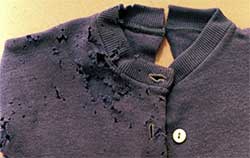
Figure 1: Damage from Black Carpet Beetle
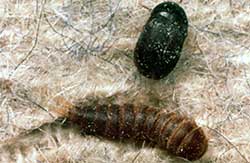
Figure 2: Black Carpet Beetle
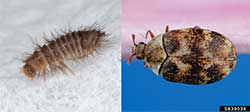
Figure 3: Varied Carpet Beetle
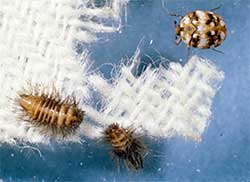
Figure 4: Furniture Carpet Beetle
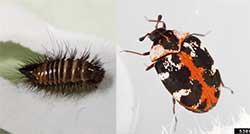
Figure 5: Common Carpet Beetle
Carpet beetles are common pests found in homes. They are responsible for more damage to carpets, rugs, and other woolens than clothes moths (Figure 1). Four species of carpet beetles are commonly found in the U.S.
Identification
The black carpet beetle (Attagenus unicolor (Brahm)) is the most common carpet beetle species (Figure 2). It is small, black, oval, and 1/8 to 3/16 inch (3–5 mm) long. The larva is carrot-shaped, golden to dark brown and up to ½ inch (13 mm) long. It has a tail of long hairs, which is a distinguishing characteristic of this species.
The varied carpet beetle (Anthrenus verbasci (L)), furniture carpet beetle (Anthrenus flavipes LeConte), and common carpet beetle (Anthrenus scrophularia (L)) are similar in their appearance and habits (Figures 3–5). The adults are typically 1/12 to 1/8 inch (2–3 mm) long and have a round body. The body has an irregular arrangement of mixed white, brownish, black, orange, or yellowish scales. The mature larva is about 1/5 inch (5 mm) long and is much shorter than the black carpet beetle. It has dense bristles and hairs at the sides and end of the body. In the varied carpet beetle, the head end is narrower than the tail end, a characteristic that distinguishes it from black carpet beetle larva.
Habits and Food
Adult carpet beetles live both outside and inside homes. Outdoors, they are found on the blossoms of crape myrtle, spiraea, Queen Anne's lace, buckwheat, daisies, wild asters, and other flowering plants with abundant pollen. Larvae feed on animal-produced debris and are often associated with animal nests. Indoors, larvae feed on a wide variety of materials. Their food include carpets, woolens, furs, stuffed animals, leather book bindings, feathers, horns, hair, silk, dead insects, dead spiders, pet food, and nests of birds, bees, and wasps. Plant products such as seeds, grain, and cereals may also be infested by carpet beetles.
Adult beetles are mostly seen in spring on flowers. They crawl or fly into dwellings through vents, windows, doors, and eaves. Carpet beetle adults are attracted to light. They are often found around windows. Adult females lay eggs on lint around baseboards, carpet edges, cracks, in ducts of hot-air furnace systems, on mouse carcasses, or in similar situations. An adult female carpet beetle lays about 40-90 eggs that hatch into tiny larvae in one to two weeks. A larva molts 8-17 times before turning into a pupa. The larval stage may be as short as 70 days and as long as more than one year, depending on the species, temperature, and food availability. Full-grown larvae change into pupae, and adults emerge after about two weeks. The adult beetles seldom live more than four weeks.
Carpet beetle larvae stay hidden in materials in which they feed. Carpet beetle infestations differ from clothes moth infestations in that the damage usually occurs in a large area or a portion of the garment or carpet rather than scattered in different areas. Carpet beetle larvae leave shed skins. They do not produce webbing as webbing clothes moths do.
Prevention and Control
Carpet beetles are often difficult to eliminate because of their ability to live in obscure places and disperse widely within a structure. Successful control relies on integrating sanitation, exclusion, non-chemical, and chemical control methods.
Exclusion
Keeping doors and windows tightly sealed will help minimize invasion of adult beetles. Eliminating flowering plants and shrubs immediately around the building will reduce pest pressure from outside. Check for the presence of beetles before bringing in cut flowers. Proper storage is most important in preventing damage from fabric pests. Valuable furs and other items of animal origin should be placed in cold storage or airtight garment bags. Before storing the articles, carefully examine them to make sure they are clean and pest-free. A tight chest or cabinet is not adequate for protecting woolens for long periods of time. Placing naphthalene or paradichlorobenzene (PDB) in a storage unit will prevent damage from fabric pests. These products should not be placed in direct contact with the articles. PDB can damage plexiglas®, many resins and furniture finishes, buttons, and ornaments on clothing.
Non-Chemical Control Methods
Inspection
The first step in the control of carpet beetles is to find the source of infestation. Dark storage rooms, lint-laden corners, heat ducts and cold-air return ducts, attics, basements, areas under slip covers on furniture, back sides of furniture, and seldom-used sofas in darkened corners all need to be inspected. Placing sticky traps around windows during the spring will catch adult varied carpet beetles trying to enter or escape to the outdoors. Food-baited sticky traps can be placed around the perimeter and corners of floors to monitor the activity of the carpet beetle larvae.
Dry Cleaning and Hot Laundering
Garments can be dry cleaned or hot laundered to kill all fabric pests.
Freezing
Non-washable items can be wrapped inside a plastic bag and placed in a household freezer for two weeks. After the treatment, the objects should be allowed to return to room temperature within the sealed plastic bag to prevent condensation damage.
Sanitation
Lint should be removed from cracks and crevices in floors and around baseboards. Frequent washing (or shampooing) and vacuum cleaning of all rugs and carpets will help. Discard the vacuum bag immediately after vacuuming to prevent vacuumed carpet beetles escaping from the bag. Remove bird, rodent, bee, and wasp nests and old spider webs outside the structure. These nests may harbor carpet beetles.
Chemical Control Methods
Dichlorvos (DDVP) impreganated resin strips (such as Nuvan® Prostrips, Vapona®) are available for repelling and controlling fabric pests. Vapona® strips can be used to treat museum display cases, storage closets, attics, storerooms, and other enclosed areas that are not regularly occupied by persons. When using them, be careful not to let them contact the article to be treated and select the right size according to the size of the space being treated. In occupied homes, Nuvan® Prostrips can be used in closets, wardrobes, cabinets, and attics. Dichlorvos is slowly released from the strip and when high enough concentrations are reached, it will kill any pests hiding on the treated articles. Closets are not airtight and are opened too frequently to hold enough vapors to kill insects. A trunk, chest, box, or garment bag makes a good storage container for killing existing fabric pests with DDVP resin strips. The strips must be replaced every four months.
Insecticide Dusts or Sprays
Areas that cannot be cleaned may need to be treated with an insecticide dust or sprays. Find a product that lists carpet beetles on its label. Diatomaceous earth dust is less toxic to humans than some other pesticides. The following active ingredients (not a complete list) are suitable for carpet beetle control: bifenthrin, beta-cyfluthrin, lambda-cyhalothrin, and permethrin. Apply insecticides as spot treatments or limit sprays to edges of floor coverings, under rugs and furniture, floors and walls of closets, shelving where susceptible fabrics are stored, cracks and crevices, and other lint accumulating areas. It is not recommended to apply insecticides on fabrics. The ability of the insects to crawl while in the larval stage reduces the effectiveness of insecticide treatments in multi-unit dwellings.
Fumigation
When infestations are severe, or where access to all sources of pest activity is limited, chemical fumigation may be the best method. The services of a pest control operator are usually needed to conduct a fumigation. Treatment with a fumigant is the surest way to penetrate numerous layers of fabrics or rolled rugs and destroys all fabric pests in infested materials. Fumigation can be completed inside of fumigation chambers, trailers, shipping containers, and fumigation bubbles; or by tarping the structure. Sulfuryl flurodie (Vikane®) and phospine are suitable for treating many articles.
An alternative and inexpensive fumigation method is to use dry ice. This is useful for fumigating stuffed animals, pillows, some furniture, etc. Thick airtight plastic bags can be used for dry ice fumigation. For each 42-gallon heavy duty garbage bag (3 mil), place 3 pounds (1,350 g) dry ice pellets near the bottom or center of the bag. Seal the bag with a string. Dry ice will evaporate into carbon dioxide within a few hours (a process called sublimation). Carbon dioxide is heavier than air and as the dry ice sublimates, air in the bag will be pushed out. As long as the bag is tightly sealed with string, the air inside the bag will contain a very high concentration of carbon dioxide for at least 2–3 days, which are adequate for killing any fabric pests. A 48-hour fumigation at around 70°F is sufficient for killing any fabric pests. Longer time will be required for lower temperatures. Wear gloves when handling dry ice. Conduct the treatment in a vented place to avoid accumulation of high carbon dioxide in the room.
Ineffective Treatments
Aerosol bombs have little value in controlling carpet beetles. The fog has very poor penetrating qualities, thereby preventing the insecticide from reaching the larvae in their hiding places.
Cedar chests are of little use in controlling fabric pests. The volatile oil from red cedar is not an effective repellent. Furthermore, studies show that after cedar chests are 36 months old, volatile essential oils in the wood are absent.
Reference
Mention or display of a trademark, proprietary product, or firm in text or figures does not constitute an endorsement by Rutgers Cooperative Extension and does not imply approval to the exclusion of other suitable products or firms.
Photo credits: Clemson University, USDA Cooperative Extension Slide Series (Figures 1, 2, and 4), Bugwood.org; Joseph Berger, Bugwood.org, (Figure 3 and 5).
March 2019
Copyright © 2024 Rutgers, The State University of New Jersey. All rights reserved.
For more information: njaes.rutgers.edu.
Cooperating Agencies: Rutgers, The State University of New Jersey, U.S. Department of Agriculture, and Boards of County Commissioners. Rutgers Cooperative Extension, a unit of the Rutgers New Jersey Agricultural Experiment Station, is an equal opportunity program provider and employer.

